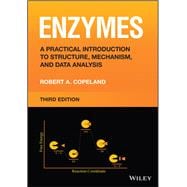A complete and approachable introduction to the study of enzymes, from theory to practice
Enzymes catalyze the bulk of important biological processes, both metabolic and biochemical. They are specialized proteins whose function is determined by their structure, understanding which is therefore a key focus of biological, pharmacological, and agrarian research, among many others. A thorough knowledge of enzyme structure, pathways, and mechanisms is a fundamental building block of the life sciences and all others connected to them.
Enzymes offers a detailed introduction to this critical subject. It analyzes enzyme proteins at the structural level and details the mechanisms by which they perform their catalyzing functions. The book’s in-depth engagement with primary literature and up-to-date research allows it to continuously deploy illustrative examples and connect readers with further research on key subjects. Fully updated after decades as the standard text, this book unlocks a thriving field of biological and biochemical research.
Readers of the third edition of Enzymes will also find:
- Expanded chapters on steady-state and transient-state enzyme kinetics, structural components of enzymes, and more
- New chapters on enzyme regulation, enzyme-macromolecule interactions, enzyme evolution, and enzymes in human health
- Key Learning Points at the beginning of each chapter to assist students and instructors
Enzymes promises to continue as the standard reference on this subject for practitioners of the life sciences and related fields in both academia and industry.








